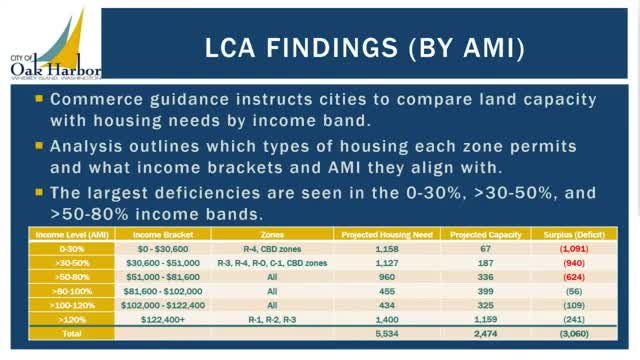City fights to redirect growth from county to urban areas
August 28, 2024 | Oak Harbor, Island County, Washington
This article was created by AI summarizing key points discussed. AI makes mistakes, so for full details and context, please refer to the video of the full meeting. Please report any errors so we can fix them. Report an error »

In a recent government meeting, officials discussed the ongoing challenges of urban growth management and the distribution of development between city and county areas. The conversation highlighted a significant trend: over the past two decades, approximately 60% of growth has occurred in the county, while only 20% has taken place within city limits. This imbalance has raised concerns about compliance with the Growth Management Act (GMA), which aims to promote orderly urban development.
Officials noted that the city has consistently expressed dissatisfaction with this trend, arguing that without intervention, development will continue to favor the county, undermining the GMA's objectives. In response, the city is implementing strategies to encourage more development within its boundaries. The allocation methodologies discussed aim to redirect growth towards the city, aligning with state guidance that mandates low-income housing units be located within urban growth areas (UGAs) rather than in rural settings.
The meeting underscored the importance of collaboration between city and county officials to address these issues effectively. As the state has already indicated its disapproval of the current distribution of development, local leaders are under pressure to adapt their strategies to ensure compliance and foster sustainable growth within the city.
Officials noted that the city has consistently expressed dissatisfaction with this trend, arguing that without intervention, development will continue to favor the county, undermining the GMA's objectives. In response, the city is implementing strategies to encourage more development within its boundaries. The allocation methodologies discussed aim to redirect growth towards the city, aligning with state guidance that mandates low-income housing units be located within urban growth areas (UGAs) rather than in rural settings.
The meeting underscored the importance of collaboration between city and county officials to address these issues effectively. As the state has already indicated its disapproval of the current distribution of development, local leaders are under pressure to adapt their strategies to ensure compliance and foster sustainable growth within the city.
View full meeting
This article is based on a recent meeting—watch the full video and explore the complete transcript for deeper insights into the discussion.
View full meeting
